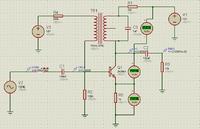StoppTidigare
Full Member level 2
- Joined
- Jul 16, 2002
- Messages
- 148
- Helped
- 1
- Reputation
- 2
- Reaction score
- 0
- Trophy points
- 1,296
- Location
- Northern earth
- Activity points
- 1,703
ads simulation hartley .dsn oscilator
Hi, I wonder if somebody can help me with an oscillator circuit.
1. Is it possible to simulate oscillation with the SPICE3f5-engine? Or do one need a Harmonic Balance -code ? (Just, heard of it, don't know what it does. Has to do something with the problems encounteed in oscillator-simulation).
2. If possible to simulate how do I increase the feedback-voltage from collector to base without compromising the 180 +180 degree phase shift (collector output + transformer)
Kindest regards,
StoppTidigare
Attaching a proteus simulation file
Hi, I wonder if somebody can help me with an oscillator circuit.
1. Is it possible to simulate oscillation with the SPICE3f5-engine? Or do one need a Harmonic Balance -code ? (Just, heard of it, don't know what it does. Has to do something with the problems encounteed in oscillator-simulation).
2. If possible to simulate how do I increase the feedback-voltage from collector to base without compromising the 180 +180 degree phase shift (collector output + transformer)
Kindest regards,
StoppTidigare
Attaching a proteus simulation file
